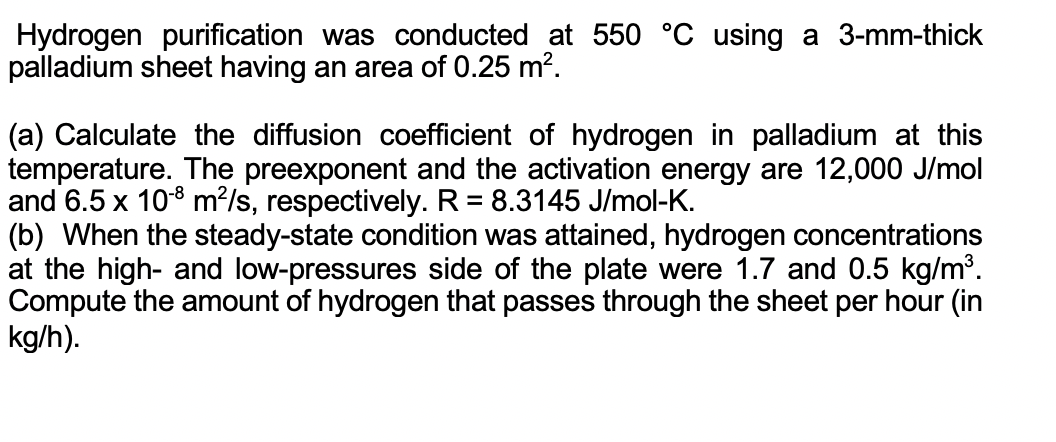Hydrogen purification was conducted at 550 °C using a 3-mm-thick palladium sheet having an area of 0.25 m?. (a) Calculate the diffusion coefficient of hydrogen in palladium at this temperature. The preexponent and the activation energy are 12,000 J/mol and 6.5 x 108 m?/s, respectively. R = 8.3145 J/mol-K. (b) When the steady-state condition was attained, hydrogen concentrations at the high- and low-pressures side of the plate were 1.7 and 0.5 kg/m³. Compute the amount of hydrogen that passes through the sheet per hour (in kg/h).
Hydrogen purification was conducted at 550 °C using a 3-mm-thick palladium sheet having an area of 0.25 m?. (a) Calculate the diffusion coefficient of hydrogen in palladium at this temperature. The preexponent and the activation energy are 12,000 J/mol and 6.5 x 108 m?/s, respectively. R = 8.3145 J/mol-K. (b) When the steady-state condition was attained, hydrogen concentrations at the high- and low-pressures side of the plate were 1.7 and 0.5 kg/m³. Compute the amount of hydrogen that passes through the sheet per hour (in kg/h).
Principles of Instrumental Analysis
7th Edition
ISBN:9781305577213
Author:Douglas A. Skoog, F. James Holler, Stanley R. Crouch
Publisher:Douglas A. Skoog, F. James Holler, Stanley R. Crouch
Chapter30: Capillary Electrophoresis, Electrochromatography, And Field-flow Fractionation
Section: Chapter Questions
Problem 30.9QAP
Related questions
Question

Transcribed Image Text:Hydrogen purification was conducted at 550 °C using a 3-mm-thick
palladium sheet having an area of 0.25 m?.
(a) Calculate the diffusion coefficient of hydrogen in palladium at this
temperature. The preexponent and the activation energy are 12,000 J/mol
and 6.5 x 108 m?/s, respectively. R = 8.3145 J/mol-K.
(b) When the steady-state condition was attained, hydrogen concentrations
at the high- and low-pressures side of the plate were 1.7 and 0.5 kg/m³.
Compute the amount of hydrogen that passes through the sheet per hour (in
kg/h).
Expert Solution
This question has been solved!
Explore an expertly crafted, step-by-step solution for a thorough understanding of key concepts.
This is a popular solution!
Trending now
This is a popular solution!
Step by step
Solved in 6 steps

Knowledge Booster
Learn more about
Need a deep-dive on the concept behind this application? Look no further. Learn more about this topic, chemistry and related others by exploring similar questions and additional content below.Recommended textbooks for you

Principles of Instrumental Analysis
Chemistry
ISBN:
9781305577213
Author:
Douglas A. Skoog, F. James Holler, Stanley R. Crouch
Publisher:
Cengage Learning

Principles of Instrumental Analysis
Chemistry
ISBN:
9781305577213
Author:
Douglas A. Skoog, F. James Holler, Stanley R. Crouch
Publisher:
Cengage Learning